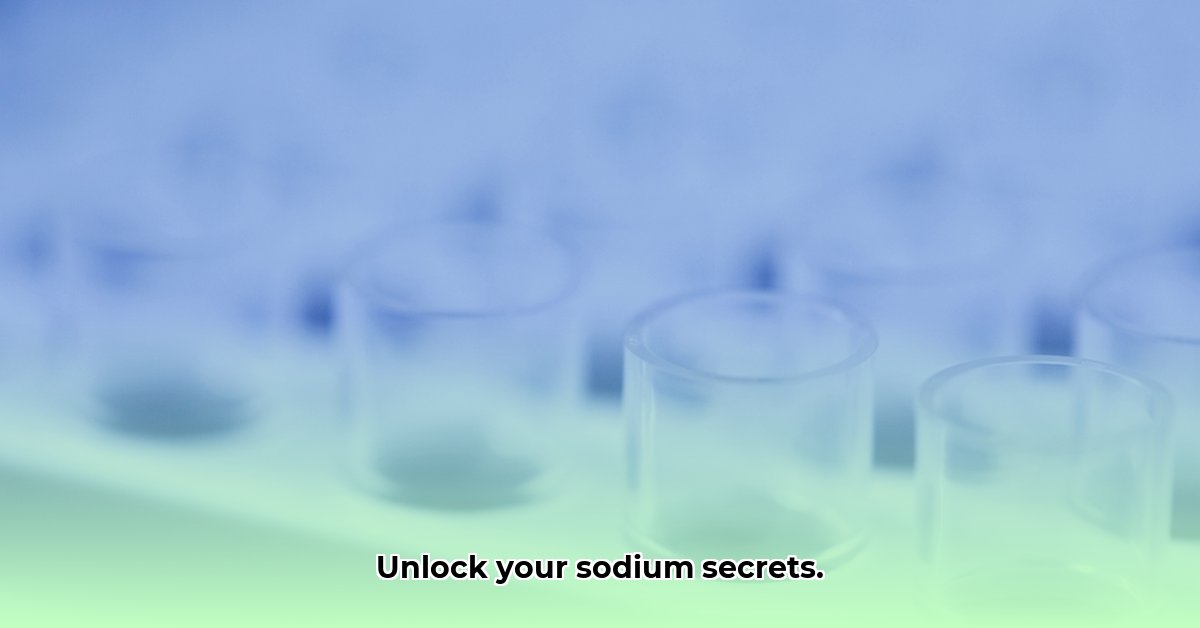Ever wondered what those sodium levels on your blood test report actually mean? It can be confusing, but understanding your sodium levels is key to staying healthy. This guide will explain everything in simple terms. We’ll cover what sodium does in your body, what “normal” levels look like, and what happens when things get out of whack – whether it’s too high or too low. We’ll also show you how to interpret your results, when you should worry, and how to discuss them with your doctor. Basically, we’ll give you the tools to understand your sodium levels and take charge of your health. For more detailed information on serum sodium, check out this helpful resource: serum sodium levels.
Decoding Your Sodium Blood Test: A Comprehensive Guide
Understanding your sodium levels is key to maintaining overall well-being and preventing health complications. A simple blood test can reveal a lot about your body’s fluid balance and overall health. Let’s dive into what a sodium blood test is, what the results mean, and what you can do to keep your sodium levels in check for optimal wellness.
Understanding the Basics: What’s a Sodium Blood Test?
Sodium is an essential mineral that helps regulate your body’s fluid balance, ensures your nerves function properly, and keeps your muscles working smoothly. A sodium blood test measures the amount of sodium in your blood. Imbalances, whether too much or too little sodium, can signal health issues ranging from mild to severe. This test provides a snapshot of your body’s internal balance, giving medical professionals valuable insight.
Normal Ranges Explained: Understanding Your Sodium Test Results
Your doctor will look at your sodium level, expressed as mEq/L (milliequivalents per liter). The generally accepted normal range is between 135 and 145 mEq/L. This is a guideline, and your personal normal range may vary slightly based on your age, overall health, and other factors your doctor will consider. Maintaining sodium balance is important for preventing severe health risks.
Let’s look at what’s considered outside of the typical healthy range:
- Hyponatremia (Low Sodium): A reading below 135 mEq/L signals a low sodium level. Several things could cause this, including drinking too much water, certain medications, kidney problems, hormonal imbalances, syndrome of inappropriate antidiuretic hormone secretion (SIADH), severe vomiting or diarrhea, or heart failure. Symptoms can vary greatly, from mild fatigue and nausea to more serious issues like headaches, confusion, and even seizures in severe cases. The severity often depends on how quickly the sodium level drops.
- Hypernatremia (High Sodium): If your level is above 145 mEq/L, it indicates high sodium. This could be due to dehydration, consuming too much salt, kidney problems, diabetes insipidus, or excessive sweating. Initially, you might just experience thirst. However, severe cases can lead to more intense symptoms like confusion, muscle weakness, seizures, and even coma. Early intervention is crucial.
It’s crucial to remember that a slightly high or low sodium level doesn’t automatically mean something is seriously wrong. Your doctor needs to consider the whole picture of your health before making any judgments.
Holistic Assessment: Factors Affecting Your Sodium Levels
Your sodium blood test result is one piece of the puzzle. Your doctor will consider several other factors to get a complete understanding of your health:
- Other Electrolytes: Sodium doesn’t work in isolation. Potassium and chloride are also crucial electrolytes, and their levels are important as they work closely with sodium.
- Hydration Status: Are you properly hydrated, dehydrated, or perhaps even overhydrated? This significantly impacts sodium levels.
- Kidney Function: Your kidneys play a vital role in regulating sodium levels. Impaired kidney function can lead to imbalances.
- Hormone Levels: Hormones like aldosterone and antidiuretic hormone (ADH) affect sodium and water balance.
- Pre-existing Conditions: If you have conditions like kidney disease, heart failure, liver cirrhosis, or diabetes, these can affect your sodium levels.
- Medications: Some medications, like diuretics (water pills), nonsteroidal anti-inflammatory drugs (NSAIDs), certain antidepressants, and some antipsychotics, can influence your sodium levels.
- Diet: While the sodium blood test doesn’t directly measure sodium intake, a diet consistently high in sodium can contribute to hypernatremia, particularly in individuals with impaired kidney function or limited access to water.
Your doctor needs all this information to accurately interpret your sodium test results. Never attempt to interpret your results on your own.
Engaging with Your Healthcare Provider: What Happens After the Test?
Once you have your results, scheduling a follow-up appointment with your doctor is essential. They’ll review your results, consider your medical history, and likely order other tests to determine the underlying cause of any imbalances. This comprehensive approach ensures a proper diagnosis and appropriate treatment plan.
Tailored Plans: Addressing Sodium Imbalances Treatment Approaches
Treatment for sodium imbalances depends on the cause and the severity.
- Hyponatremia Treatment: Treatment may involve limiting fluid intake, adjusting medications, administering intravenous sodium solutions, or treating underlying conditions such as heart failure or kidney disease. In severe cases, hypertonic saline may be administered under close monitoring.
- Hypernatremia Treatment: Treatment typically involves fluid replacement, either orally or intravenously. In some cases, diuretics may be used to help the kidneys eliminate excess sodium. Underlying conditions such as diabetes insipidus also need to be addressed.
Your doctor will create a personalized plan based on your specific needs and situation.
Healthy Habits: Keeping Your Sodium Levels in a Healthy Range
While a sodium blood test doesn’t directly measure your dietary sodium intake, what you eat and drink plays a substantial role in maintaining healthy sodium levels.
- Hydration is Key: Aim to drink plenty of water consistently throughout the day. The general recommendation is to drink when you are thirsty.
- Mind Your Salt Intake: Be mindful of salty processed foods and snacks. The American Heart Association recommends no more than 2,300 milligrams (mg) of sodium per day for most adults, with an ideal limit of no more than 1,500 mg per day.
- Read Food Labels: Pay attention to the sodium content listed on food labels, and choose lower-sodium options when available.
- Cook at Home: Try to cook more at home, using fresh ingredients and herbs to add flavor instead of relying on salt.
- Regular Checkups: Regular health checkups are crucial, especially if you have an underlying health condition. This allows for early detection and management of any potential sodium imbalances.
Understanding Health Risks: Potential Risks of Unmanaged Sodium Imbalances
Both very low (hyponatremia) and very high (hypernatremia) sodium levels can be serious if left unaddressed.
- Hyponatremia Risks: Severe hyponatremia can lead to brain swelling, seizures, coma, and even death. Chronic hyponatremia can cause gait disturbances, attention deficits, and increased risk of falls.
- Hypernatremia Risks: Severe hypernatremia can cause dehydration, seizures, coma, brain damage, and death. Rapid correction of hypernatremia can lead to cerebral edema.
Early diagnosis and intervention are extremely important, and this is why regular checkups are crucial. Early diagnosis plays a vital role in preventing severe health risks.
Understanding Imbalances: Severity and Onset of Sodium Imbalances
Here’s a table summarizing the potential severity and speed of onset for both hyponatremia and hypernatremia. Keep in mind that these are general guidelines; individual experiences may vary.
| Condition | Severity | Onset Rapidity | Potential Consequences |
|---|---|---|---|
| Hyponatremia | Mild | Gradual | Fatigue, mild nausea |
| Moderate | Relatively rapid | Headache, confusion, vomiting, muscle weakness | |
| Severe | Sudden | Seizures, coma, brain damage, death | |
| Hypernatremia | Mild | Gradual | Increased thirst, mild muscle weakness |
| Moderate | Relatively rapid | Restlessness, vomiting, significant muscle weakness, confusion | |
| Severe | Sudden | Seizures, coma, brain damage, death |
Important Note: This information is intended for educational purposes only and shouldn’t be seen as a replacement for professional medical advice. Always consult your healthcare provider for any health concerns and before making any decisions related to your health or treatment. They can provide personalized guidance based on your unique circumstances. Ongoing research is constantly refining our understanding of sodium levels and their impact on health, so stay informed and discuss any concerns you have with your doctor.
Interpreting Slightly Elevated Sodium Blood Test Results
Key Takeaways:
- A normal sodium level is typically between 135 and 145 mEq/L.
- Slightly elevated sodium (hypernatremia) means your level is above 145 mEq/L and can indicate dehydration or underlying health problems.
- Many factors influence sodium levels, including medications and overall health.
- See your doctor to properly analyze slightly elevated sodium blood test results.
- Treatment depends on the cause and severity of the elevation.
Test Mechanics: What Does a Sodium Blood Test Measure?
Your blood sodium test measures the
- Wellness Fair Ideas for Work to Boost Employee Wellbeing - December 15, 2025
- Affordable Employee Wellness Fair Ideas for Any Budget - December 14, 2025
- Employee Wellness Programs Strategically Benefit Employee Health And Retention - December 13, 2025
















